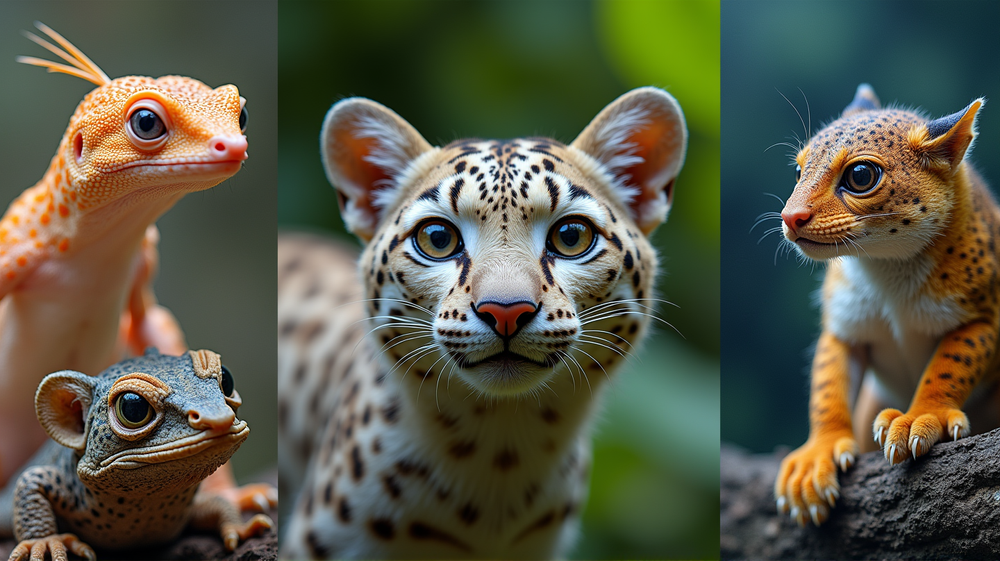Imagine walking through a dense forest or a snowy mountain range and being surrounded by creatures you can’t even see. This is the magic of nature’s camouflage artists—animals that masterfully blend into their surroundings, rendering themselves invisible to both predators and prey. These extraordinary animals have evolved some of the most fascinating adaptations, crucial for their survival. Let’s dive into the mysterious world of these incredible shapeshifters.
The Leaf-tailed Gecko: Master of Deception
Nestled in the lush environments of Madagascar, the leaf-tailed gecko is an expert in mimicry. It looks uncannily like a dried leaf, with intricate veining and torn edges. This makes it virtually undetectable, a survival trick it uses to evade hungry birds and other predators during daylight hours.
Ghost of the Mountains: The Elusive Snow Leopard
The snow leopard, often called the “ghost of the mountains,” perfectly exemplifies the art of camouflage. Its fur, a tapestry of smoky gray dotted with rosettes, blends seamlessly into the rocky outcrops of Central Asia’s vast ranges. This camouflage allows it to remain unseen by both its prey and human admirers.
Under the Sea: The Shapeshifting Cuttlefish
In the ocean’s depths, the cuttlefish reigns supreme as a master of disguise. With chameleon-like abilities, it can alter its color, texture, and pattern to perfectly blend in with its underwater environment—be that sand, coral, or seaweed. This ability not only helps it hide but also aids in becoming an effective hunter, as stated in TimesOfIndia.com.
Walking Twigs: The Stick Insect’s Hidden Talent
Stick insects, or walking sticks, inhabit a world of still and silent deception. Resembling the twigs among which they reside, these insects are nearly impossible to spot, particularly in dense vegetation—an evolutionary strategy that offers near-perfect concealment from avian predators.
Tiny, Hidden Treasures: The Pygmy Seahorse
Tiny yet perfectly camouflaged, the pygmy seahorse is one of the ocean’s most intriguing creatures. This diminutive 2 cm marvel hides in plain sight on coral fan structures, with its color and texture blending so seamlessly that it went unnoticed by science until 1969.
The Vanishing Eastern Screech Owl
Eastern screech owls use expert camouflage to blend into their wooded environments. Their feathers are patterned to mimic tree bark, enabling them to roost, undisturbed, against tree trunks, melding into the landscape to avoid detection.
Flounder: The Ocean’s Undercover Agent
The flounder is an actor of high esteem, transforming its skin tone to match the sandy ocean floor or rocky substrate. This agility in color change provides both a means of stealthy hunting and an escape from its own pursuers.
Nature’s Leaf Impersonator: The Dead Leaf Mantis
Residing quietly in Asian forests, the dead leaf mantis perfects the art of stillness and subterfuge. When stationary, it is indistinguishable from a brown, curled-up leaf, a dual strategy of defense and ambush.
Color Artists: The Chameleons
Chameleons epitomize adaptive genius with their well-known skin transformations. These color changes can signal mood, communication, or serve as a dynamic camouflage, supporting the chameleon’s dual lifestyle of predation and evasion.
Seasonal Shapeshifter: The Arctic Fox
The arctic fox stands as the emblematic seasonal transformer. With pure white fur in snowy winters and a muted summer coat to match the tawny tundra, it remains a steadfast spirit of the changing seasons, perpetually elusive and monumentally adaptable.
In the myriad landscapes of the world, the power of invisibility is a riveting testament to evolution’s artistry. From the whispering canopies of tropical forests to the icy vastness of the Arctic, these vivid examples of camouflage remind us that sometimes, the most extraordinary things are those we cannot see.













